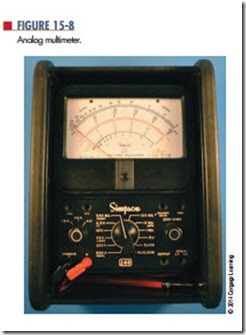Multlmeters
When working on a piece of equipment, many different measurements must be taken. To eliminate the need for several meters, the voltmeter, ammeter, and ohmmeter can be combined into a single instrument called a multimeter. An analog multimeter is referred to as a volt-ohm-milliammeter (VoM), Figure 15-8. A digital multimeter is also referred to as a dMM.
The meter in Figure 15-8 has five voltage positions, four current positions, and three resistance positions. There are five scales on the meter to accommodate the various ranges and functions. The technician selects the switch on the multimeter for the desired voltage, cur- rent, or resistance range. The zero-ohm control adjusts the ohmmeter circuit to compensate for variations in the voltage of the internal batteries. The function switch has three positions: 2DC, 1DC, and AC. To measure current, DC voltage, and resistance, the function switch is placed at 2DC or 1DC, according to the polarity of the applied current or voltage. The function switch permits reversal of the test lead connections without removing the leads from the circuit being tested.
To measure DC voltage, set the function switch to 1DC. With the function switch set at 1DC, the common jack is negative and the plus jack is positive. The voltmeter is connected in parallel with the circuit. When measuring an unknown voltage, always set the meter to the highest range (500 volts). If the measured voltage is lower, a lower position can be selected. This procedure protects the meter from damage. Read the voltage on the scale marked DC. For the 2.5-volt range, use the 0–250 scale and divide by 100. For the 10-volt, 50-volt, and 250-volt ranges, use the scales directly. For the 500-volt range, use the 0–50 scale and multiply by 10.
To measure current, the selector switch is set for the desired current position and the meter is connected in series with the circuit. The DC scale on the meter is used. For the 1 mA range, use the 0–10 scale and di- vide by 10. For the 10 mA range, use the 0–10 scale directly. For the 100 mA range, use the 0–10 scale and multiply by 10. For the 500 mA range, use the 0–50 scale and multiply by 10.
To measure resistance, set the selector switch to the desired resistance range. Short the test leads together. Rotate the zero-ohm control until the pointer indicates zero ohms. Separate the test leads and connect them across the component being measured. For measuring resistance between 0 and 200 ohms, use the R 3 1 range. To measure resistance between 200 and 20,000 ohms, use the R 3 100 range. For resistance above 20,000 ohms, use the R 3 10,000. When measuring resistance in digital and semiconductor circuits, do not use the R 3 1 scale. This scale is energized by a 9 V battery and could damage the circuitry. Observe the reading on the ohm scale at the top of the meter scales. Note that the ohm scale reads from right to left. To determine the actual resistance value, multiply the reading by the factor at the switch position. The letter K equals 1000.
To use the other voltage and current jacks located on the multimeter, refer to the operator’s manual.
With a DMM, the meter movement is replaced by a digital readout, which is similar to the readout used in an electronic calculator. The difference is that the display is typically four digits.
The controls of a DMM are similar to those found on an analog meter. The exception is with a digital me- ter that has an autoranging feature. It does not need to identify the range of the signal being tested.
The readout of the DMM automatically places the decimal point with the appropriate unit prefix. DC
measurements are displayed with a 1 or 2 sign. This avoids the necessity of reversing the test leads.
The advantages of DMMs over VOMs include these:
● Easier readability, resulting in a higher ac- curacy with smaller voltage, and results that are repeatable with different readers
● Autoranging capabilities
● Autozeroing for resistance reading
● Autolock of a displayed value
The disadvantages of a DMM include these:
● Requirement for batteries or other source of electricity
● Voltage limitation that if exceeded could seriously damage the meter
● Inability to measure an instantaneous change in a signal that is faster than the sampling time
Questions
1. What is a multimeter?
2. What is an analog multimeter called?
3. What is a digital multimeter called?
4. Explain how to use the ohmmeter portion of a VOM.
What are the advantages of the DMM over the VOM?
